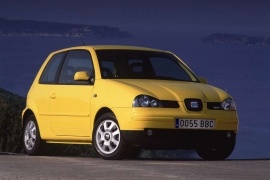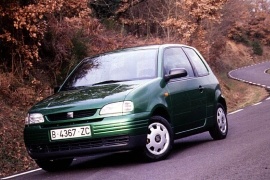SEAT Arosa Models/Series Timeline, Specifications & Photos
First production year: 1997
Engines: Gasoline, Diesel
Body style: Hatchback
In 2000, the Spanish automaker SEAT had to refresh its smallest vehicle, the Arosa, for the 2001 model year and according to the Euro 3 emission standards, which became mandatory for all vehicles starting in January 2001.
Volkswagen Group understood the power of badge engineering and made two almost identical vehicles: the own-branded Volkswagen Lupo and the SEAT Arosa. Both cars have been built in the Spanish automaker’s factory at Martorell and exported all over Europe and in UK. While at first, it wasn’t such a tremendous success, later, these vehicles became appealing for those who needed a supermini car for the urban commute thanks to their excellent fuel efficiency. SEAT even tried to create a sportier version of this version and unveiled the Arosa Racer concept at the 2001 Frankfurt Motor Show but never introduced it in production.
The 2001 Arosa went through a significant upgrade in terms of styling. Its front fascia featured new headlights with taller outer sides, clear lenses, dual headlamps, and turn signals behind it. These fronted the fresh grille that followed the carmaker’s design language and showed a center-mounted badge inside a body-colored rectangular trim. Furthermore, the bumper sported a lower apron fitted with tiny fog lamps on their outer sides, offered as an option. Along with the bumper and the grille, SEAT also had to redesign the hood, which featured two creases extended from the badge towards the windshield.
From its profile, the redesigned front fenders featured new, clear lens turn signals. Depending on the grade and options, the Arosa got either steel wheels with plastic caps or alloy wheels. Its body-colored door mirror caps became available for a wider range of versions, and the formerly used black rubber side stripes were replaced with body-colored ones. Finally, at the back, the flat and vertical tailgate was reshaped to accommodate the new corner-mounted taillights. The car’s bumper was also new and, for the sportiest version, featured a center-mounted exhaust.
Still, the most significant upgrade happened on the inside, where SEAT completely changed the cabin. It introduced a new dashboard with a rounded-shaped instrument cluster instead of the squarish-looking one used in the 1997 model year. Furthermore, on the center stack, the Arosa got a new stereo and a cleaner layout for buttons and switches. Another improvement was for the front seats, which were improved with higher bolstered areas (available at extra cost). In the back, there was nothing SEAT could do to improve the Arosa and upgrade the materials used there.
Under the hood, SEAT offered the Arosa with a range of five engines fed by gasoline or diesel. Power ranged between 50 PS (49 hp) and 101 PS (99 hp). Besides the 60 PS (59 hp) 1.4-liter spark-ignited version, which was also available with a four-speed automatic, all the other versions sent their power to the front wheels via a five-speed manual.
The Spanish company, Seat, was founded in 1950 with the aid of Fiat. Once the partnership with Fiat ended, Seat found itself in a difficult situation as the company’s reduced dimensions were blocking its self-development. Thus, in 1982 they started an alliance with the Volkswagen Group.
The Seat Arosa was actually the less expensive version of a Volkswagen Polo, however, it was a quiet, refined, sophisticated and a well equipped vehicle. Plus, the Arosa was sold with a 3 year warranty in comparison with the Volkswagen’s warranty of 12 months.
Although it was a 4-seater, the passengers in the rear would not feel very comfortable due to limited head and mostly reduced legroom. However, the front seats offered great comfort and enough space even for a taller person.
The Arosa could be equipped with twin airbags, ABS and even air conditioning, which was more likely to see on a luxury car in 1997.
Even with the optional packages for comfort, safety and style included, the car was more than affordable. Even if it was an entry car, it had mid-range specs.
The Arosa was sold with 3 engine options, 2 petrol and 1 diesel - all of them having a low fuel consumption.
The car was a good match for the city traffic, however, it did not offer a rewarding ride on the highway. And it was not built for that. Its trunk did not have enough capacity to fill it up with luggages for a holiday.
The Arosa won its customers for its price and features.

